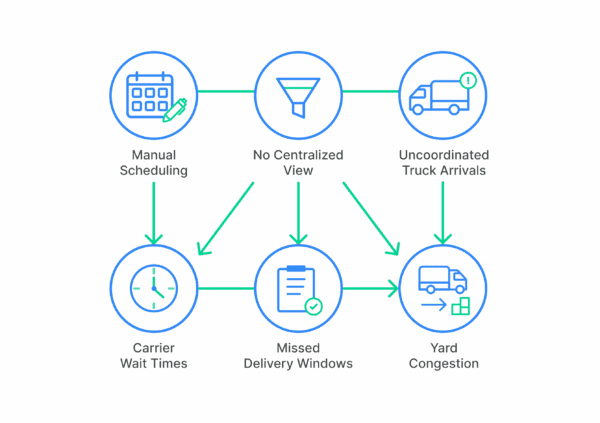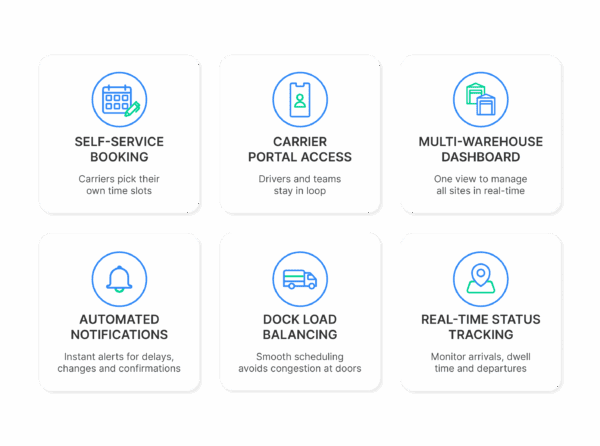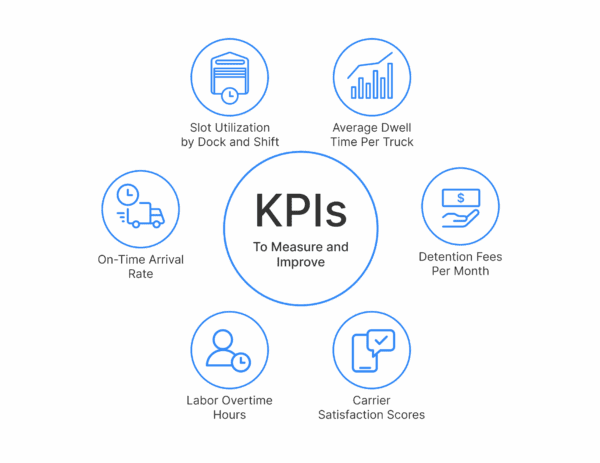
Every minute a truck waits outside your warehouse is a minute lost to inefficiency. At such times, “The last thing your workflow needs is another bottleneck.” For distribution centers, which are a strategic hub of the supply chain, juggling tight delivery windows, rising freight volumes, and shrinking labor pools, dock congestion has become a choke point that too few are solving.
Even though many warehouses invest in automation and smarter tools for internal processes such as picking and storing, many still rely on outdated methods to coordinate the unloading or loading dock.
💡 Did You Know?
According to the Pitney Bowes report, global logistics & parcel volumes have risen more than 3.4% between 2023 & 2024. Meanwhile, McKinsey estimates U.S. shippers lose $95 billion annually due to inefficient scheduling, detention fees, and idle labor.
These inefficient handovers in logistics are called “blind handoffs” and account for up to 13-19% of the costs of the warehouse, which can be significantly reduced by simply integrating an efficient Dock Scheduling System on the dock.
Based on our experience in the field, we’ve taken a closer look at the core challenges and the value of smart dock scheduling software and outline exactly why the right tech at the right touch point is vital for your distribution center.
Common Challenges of Distribution Centers
The truth is that most distribution centers were never built to handle the current volume. Before e-commerce took over, the traffic at the dock was pretty predictable, with even flows. A few trucks per hour, steady staffing, and plenty of space to maneuver.

Some of the common challenges linked with distribution centers, a real bone in the throat, are as follows:
Slower Operations Due to Manual Scheduling
Most warehouses still rely on outdated tools to manage appointments. Spreadsheets, emails, and phone calls introduce inefficiencies, errors, and redundancies. Coordination becomes a full-time job, and small mistakes, like forgetting to update a dock slot, can lead to major disruptions.
No Centralized View Creates Slot Conflicts at the DC
Without a centralized view of scheduled appointments, teams often work in silos. This lack of real-time visibility leads to slot conflicts, overbooking, and last-minute rescheduling. When two trucks show up for the same dock at the same time, the result is gridlock.
Missed Delivery Windows That Disrupt Planned Workflows
Tight SLAs are standard in today’s logistics environment. Without an efficient system, deliveries miss their window due to miscommunication or unanticipated delays, putting contracts, compliance, and carrier relationships at risk.
Uncoordinated Truck Arrivals Cause Yard and Dock Congestion
When trucks arrive in clusters or without confirmed time slots, congestion builds at the gate, in the yard, and at the docks. This clogs operations and delays other inbound and outbound shipments.
Carrier Wait Times That Lead to Detention Fees
Everyone knows waiting costs money. According to the FMCSA, detention-related costs exceed $1 billion annually. Every hour a carrier spends idle is a hit to your reputation and bottom line.
Labor Mismanagement
Unpredictable dock activity makes it nearly impossible to match labor supply with demand. Either workers stand around waiting for trucks to arrive or scramble in overtime mode to clear unexpected congestion. Let’s understand with an example:
📅 Morning at the Dock
- 8:00 AM: Five trucks arrive early for a 9:00 AM slot due to poor visibility into schedules.
- Dock 2: Still occupied from the night shift.
- Problem: Without real-time alerts, staff scramble instead of preparing, productivity plummets.
- Impact: Congestion charges soar, and a key customer delivery is missed.
If you had the right scheduling system, it could have easily given carriers and shippers the right visibility into which docks are available for particular docks.
What Is Smart Dock Scheduling Software?
If your docks feel chaotic, smart scheduling software is the simplest way to bring order to the chaos. Rather than managing appointments across dozens of emails and spreadsheets, you have a single digital system that keeps everyone in sync. That’s exactly what Dock Scheduling Software does.
Instead of relying on manual communication, the software creates a shared digital portal. It is an ecosystem where distribution center staff, carriers, and 3PL partners can interact in real-time.
Core Capabilities:
Here is a brief list of its core capabilities you can use to bring harmony in your distribution center:

Self-Service Appointment Booking: Carriers can select available time slots via a web portal or even from a shared link. If deployed, dynamic calendar carriers can even select their own choice of dock according to load type. This reduces the back-and-forth of email and phone scheduling and ensures slots are chosen based on your defined rules.
Carrier Portal Access: To have end-to-end visibility on the dock, centralized portal access can give drivers, shippers, and logistics teams the ability to check appointment status, receive updates, and reschedule if needed without calling the warehouse.
Multiple Warehouses: If your distribution center operates at multiple places, such as 3PL, the Dock Scheduling System can help you create a single, intuitive dashboard, so all the control is at your fingertips. You can effortlessly create and manage multiple distribution centers, all while coordinating warehouse schedules in real-time, regardless of their physical location. This singular application helps in fulfilling and distributing goods faster across all ventures.
Automated Notifications: Admins can send real-time alerts to staff and carriers for changes, delays, or confirmations, ensuring no one is left in the dark.
Load Balancing Between Docks: Your applied planning on the system, such as adding buffer time between slots, so that your dock can be prepared for the next unload, & can distribute appointments across available doors to reduce congestion.
Real-Time Status Tracking: Arrival, check-in, dwell time, and departure can all be tracked from a central dashboard.
When integrated with systems like Warehouse Management System (WMS), Yard Management System (YMS), or Transportation Management System (TMS), dock scheduling software becomes a linchpin for synchronized, visible, and scalable distribution operations.
Boost Your Operations by 25%
Explore Arrivy’s multi-warehouse capabilities and accelerate efficiency.
Top Business Benefits of Smart Dock Scheduling
The main concern of everyone is benefits, and it’s a crucial step as well.
Quicker Cycle Time
By ensuring trucks arrive when slots are available, dock scheduling software can reduce dwell times by up to 3x.
Reduced Detention Fees
Improved appointment accuracy and better communication help eliminate the avoidable delays that lead to detention charges. Facilities that use smart scheduling routinely report fewer penalty bills.
Learn how to reduce detention fees in the Distribution Center in just 4 steps
Increased Dock Efficiency
Load balancing algorithms ensure every dock is actively engaged. Instead of a few overused docks and others underused, utilization is optimized across the board.
Improved Carrier Partnerships
Transparency and efficiency lead to better customer experiences. With clear scheduling, minimal delays, and two-way communication, carriers are more likely to view your warehouse as a shipper of choice.
Labor Optimization
Predictable schedules allow staffing to align with actual workload. This avoids inadequate utilization during drops and burnout during peaks.
Metrics You Can Finally Measure and Improve
Here are the KPIs that matter most once you digitize scheduling:
- Average Dwell Time per Truck: Track how long vehicles spend on dock and set improvement goals, e.g, 90 minutes.
- On-Time Arrival and Departure Rates: Higher adherence to appointments means smoother operations. Target: 60–75 minutes.
- Slot Utilization by Dock and Shift: See which doors are underused, and optimize accordingly. Target: 85–95%.
- Detention Fees per Month: Measure real savings from reduced delays.
- Carrier Satisfaction Scores: Monitor feedback and improve retention.
- Labor Overtime Hours: Reduce unplanned staffing costs with better forecasting.
These KPIs create a performance baseline and serve as a post-implementation scorecard for measuring ROI.

Why Now? Trends Forcing the Shift
There’s a reason more operations leaders are rethinking their dock processes: Strategies that were effective half a decade ago are no longer sufficient for modern demands. In this case, Scheduling Software is quickly becoming a non-negotiable. Here are some trends:
eCommerce and Omnichannel Pressure: Order cycles are shorter. Customer expectations are higher. And parcel volume continues to surge.
Driver Shortages: With the U.S. short more than 80,000 truck drivers (according to the American Trucking Association), every minute of dwell time becomes a bottleneck and a competitive disadvantage.
Supply Chain Automation: Three out of four warehouses have adopted automation for storage and picking. But many still handle scheduling manually. That mismatch creates inefficiencies that ripple across the operation.
Sustainability Demands: Fewer idle trucks mean fewer emissions. Smart dock scheduling helps meet Environmental, Social, and Governance (ESG) goals without expensive infrastructure changes.
Choosing the Right Dock Scheduling Platform
Before investing in the right dock scheduling software, here’s what to look for:
Carrier-Friendly UX: If it’s not easy, partners won’t use it. Look for intuitive portals.
Flexibility: The platform should adapt to different shift schedules, dock types, and appointment rules.
Data & Reporting: Built-in analytics to track trends, exceptions, and performance by dock, carrier, or shift.
Conclusion
To summarize, an organized dock scheduling system provides quicker truck turnarounds, more fluid yard traffic, and stricter compliance, all without damaging product integrity or customer faith.
As volumes increase, labor becomes scarce, and demands escalate, reactive coordination isn’t viable anymore. Dock Scheduling Software allows distribution hubs to shift from reacting to forecasting and deliver visibility, structure, and control to a very delicate spot in the supply chain.
Final Tip: Put money into scheduling tools that give power to your logistics teams, and keep carriers in line through innovative self-booking portals.
